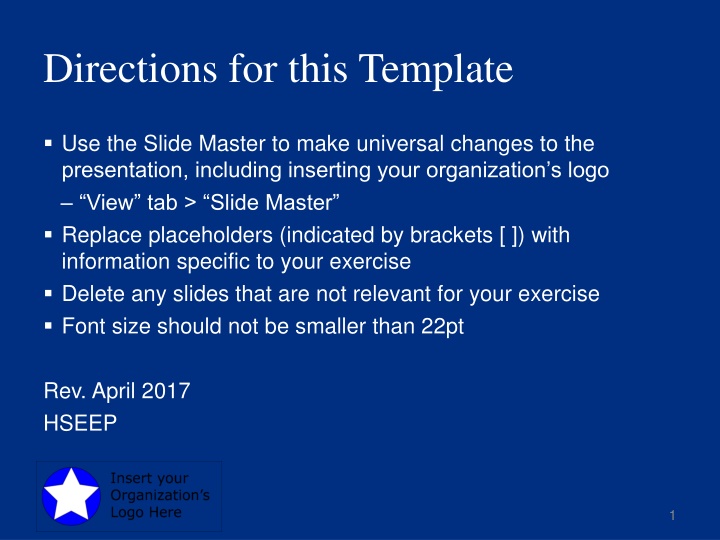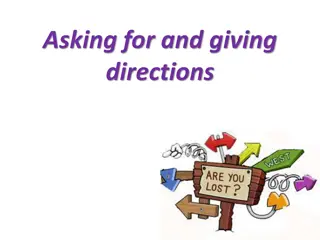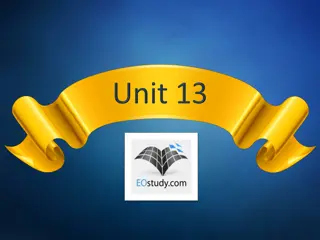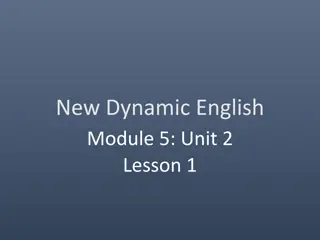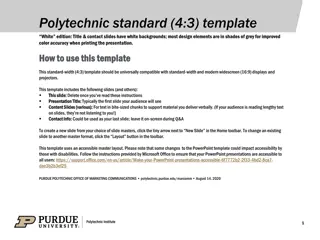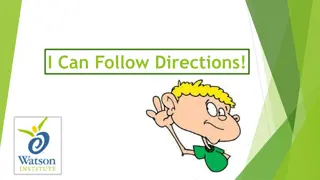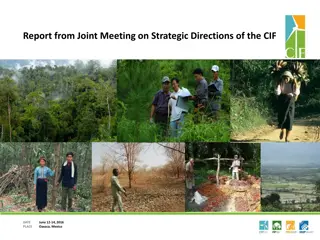Directions for this Template
This presentation provides an overview of a tabletop exercise focused on responding to an infectious disease outbreak within an educational setting. Participants will evaluate response concepts, plans, and capabilities, aiming to validate coordination and communications, verify response policies, and identify strengths and weaknesses in emergency plans related to infectious diseases. The exercise objectives are aligned with FEMA Core Capabilities and CDC Public Health Preparedness Capabilities, covering areas such as planning, communications management, mitigation measures, and health and safety protection for students and employees.
Download Presentation

Please find below an Image/Link to download the presentation.
The content on the website is provided AS IS for your information and personal use only. It may not be sold, licensed, or shared on other websites without obtaining consent from the author.If you encounter any issues during the download, it is possible that the publisher has removed the file from their server.
You are allowed to download the files provided on this website for personal or commercial use, subject to the condition that they are used lawfully. All files are the property of their respective owners.
The content on the website is provided AS IS for your information and personal use only. It may not be sold, licensed, or shared on other websites without obtaining consent from the author.
E N D
Presentation Transcript
Directions for this Template Use the Slide Master to make universal changes to the presentation, including inserting your organization s logo View tab > Slide Master Replace placeholders (indicated by brackets [ ]) with information specific to your exercise Delete any slides that are not relevant for your exercise Font size should not be smaller than 22pt Rev. April 2017 HSEEP 1
K-12 COVID 19 Self-Administered Tabletop Exercise Evaluator Briefing [Date]
Welcome and Introductions Name Organization 3
Meeting Agenda [Time] [List meeting agenda items] 4
Exercise Overview This exercise will provide participants with an opportunity to evaluate current response concepts, plans, and capabilities for a response to an infectious disease in [Institute of Higher Education]. The goal is for participants to validate coordination and communications capabilities for all-hazard incidents, verify policies and procedures for responding to infectious disease outbreaks, and to identify the overall strengths and weaknesses of emergency plans.
Objectives and Core Capabilities The Objectives for this exercise were matched to both FEMA Core Capabilities and the CDC Public Health Preparedness Capabilities. The Exercise Director and key stakeholders will determine which capabilities are to be observed during the exercise. The exercise may have capabilities from both FEMA and the CDC. 6
Objectives and Core Capabilities Objective 1: Participants will discuss existing plans and identify planning gaps as they relate to managing a positive COVID-19 case within the school district. Aligns to Planning Objective 2: Participants will identify strategies for managing communications that build confidence while properly informing and protecting the students, employees, and their families. Aligns to Public Information and Warning 7
Objectives and Core Capabilities Objective 3: Participants will discuss mitigation and protection measures that can be put into place to protect students and employees supporting the continuity of learning. -Aligns to Physical Protective Measures Objective 4: Participants will identify and discuss plans and procedures that protect the health and safety of students and employees and can be implemented while supporting continuity of learning. Aligns to Environmental Response/Health and Safety 8
Scenario- Module 1 Faculty and staff return Faculty begin preparations for the return of students in late July, approximately two weeks before students are expected to return to campus and begin classes. Since classes were moved online in Spring 2020, faculty and staff who reside on campus have practiced considerable social distancing and those who live off campus have been encouraged to visit campus as little as possible to reduce the risk of transmitting COVID-19. An administrative assistant for the Dean of Student s Office returns to work along with other faculty members. On her fourth day back at work, she develops a fever and cough shortly after returning from her lunch break and is sent home according to newly revised campus student/employee health protocols for those with COVID-19-like illness. After visiting her doctor and being tested, it is determined the employee is positive for COVID-19. Her illness is mild and she is able to recover at home while in isolation. The employee reports her illness and positive lab result to her department supervisor who immediately reports her diagnosis to school leadership. 9
Scenario Module 1 Faculty and staff return (Continued) The ill staff member is cooperative when asked to report where she had been during her infectious period (when she was possibly able to transmit COVID-19 to others), and consents to health department investigators sharing her diagnosis with her possible contacts in an attempt to identify others who might have been exposed, enroll them into contact monitoring, and reduce the risk of any contacts who become ill from spreading COVID-19. As faculty and staff had only just begun to return to work fully and practiced enhanced precautions, it is determined the case- patient likely exposed only 10-12 faculty and staff members at the school. 10
Scenario- Module 2 Students return and classes resume at dogwood academy; a student becomes ill Just over two weeks have passed since the staff member tested positive for COVID-19. School leadership, in close partnership with the local health department, have worked diligently to perform contact tracing and monitoring. Only the spouse of the ill staff member has tested positive for COVID-19 and since he was a known contact, he had been in quarantine well before his illness started and did not spread COVID-19 to others. Like his spouse, his illness was mild and he has recovered. No other instances of COVID-19-like illness have been reported among faculty or staff, despite extensive screening procedures that were enacted after the initial case was reported. Students begin to return to campus in mid-August through a staggered move-in process to allow for additional social distancing. Orientation and advising activities were conducted virtually prior to the arrival of students on campus in order to avoid large gatherings of students and faculty. Classes begin online and in-person via a hybrid educational model three days after all students have returned to campus. Most students are compliant with established social distancing protocols, use of cloth face coverings, etc. and the semester is off to a smooth start overall. 11
Scenario- Module 2 Students return and classes resume at dogwood academy; a student becomes ill (Continued) On the fifth day of classes, a senior student reports to the student health center complaining of headaches, general malaise, and difficulty breathing. He is referred to the local hospital where he is tested for COVID-19. While waiting for respiratory swab to be taken, his nurse notices he has become lethargic and doctors perform a more extensive examination of the patient. Given his low oxygen saturations and underlying medical conditions, he is admitted for further workup. Six hours after he is admitted to the hospital, the laboratory reports he has tested positive for COVID-19. The local health department is aware of the case because the case-patient was reported to the health department by hospital infection control staff and a health department investigator reaches out to the school to conduct a case/contact investigation. Initial information provided to the health department from the hospital indicates that the student is a 17 year old day student who resides off campus. He is enrolled in two in-person courses this semester and he reported that in both classrooms, students practiced social distancing and wore masks. He is willing to ensure compliance with isolation requirements once he is discharged from the hospital, but refuses to name his potential contacts for fear of getting them in trouble. 12
Scenario- Module 3 Additional cases reported, contact tracing intensifies Two close friends of the ill student who often eat lunch with him are tested and found to be positive for COVID-19. Both live on campus and report numerous contacts among students and staff members. Further, upon interviewing the two newly ill students, it is discovered they were only marginally compliant with policies requiring social distancing and the use of cloth face coverings. They also report having taken two trips into town with the index case on the weekend where all three students visited multiple shops and restaurants. It is estimated that about 100 students and 25 faculty and staff may have been exposed to COVID-19 and an unknown amount of local residents may have been exposed when the students were in town. 13
Exercise Participants [List all exercise participants; identify those with limited extent of play (e.g. XXX hospital extent of play is 8 AM to 12 noon)] 14
Exercise Assumptions & Artificialities In any exercise, assumptions and artificialities may be necessary to complete play in the time allotted and/or account for logistical limitations. Exercise participants should accept that assumptions and artificialities are inherent in any exercise, and should not allow these considerations to negatively impact their participation. During this exercise, the following apply: The exercise is conducted in a no-fault learning environment wherein capabilities, plans, systems, and processes will be evaluated. The exercise scenario is plausible, and events occur as they are presented. All players receive information at the same time. Preparedness efforts across IHE s may differ. COVID-19 will still remain a Public Health concern until a vaccine is developed [List others, as appropriate] 15
Exercise Play [Start and anticipated end timelines] [Venue sites] [Play will be restricted to the scenario details] The facilitator will guide participants through exercise discussion and will control the time and discussion details 16
Exercise Schedule Evaluator briefing: [Date/time] [Date] Participant registration: [Time] Player briefing: [Time] Start of exercise (StartEx): [Time] End of exercise (EndEx): [Time] Hot Wash: Immediately after EndEx [Date] Evaluator debriefing: [Time] 17
Exercise Location and Area [List any maps or site layouts necessary for exercise discussion] 18
Exercise Identification Evaluators Facilitators Support staff Players Observers Media [color] badges [color] badges [color] badges [color] badges [color] badges [color] badges 19
Documentation Facilitator/Evaluator Handbook Exercise Evaluation Guides (EEGs) Situation Manual Exercise Objectives Rules of Exercise Play Scenario Discussion Questions Exercise Evaluation Guides Participant Feedback Form 20
Administrative Details [Restroom locations] [Food and water] [Others as necessary] After the Hot Wash, please return: All badges All documentation (EEGs and any notes/logs) Participant Feedback Forms 21
Evaluation Overview The goal of exercise evaluation is to assess an organization s capabilities to accomplish a mission, function, or objective Evaluation is accomplished by: Observing the event and collecting supporting data Analyzing the data to compare performance against expected outcomes Reporting exercise outcomes in the AAR 22
Evaluator Responsibilities Understand the exercise objectives, core capabilities, concept, and scenario Be familiar with the plans, policies, and procedures for the function or organization being evaluated Use EEGs to document performance relative to exercise objectives, core capabilities, capability targets, and critical tasks Collect and submit all evaluation data, EEGs, and materials to the Lead Evaluator after the exercise Additional information is listed in the C/E Handbook 23
Evaluator Guidelines DO: Observe and record player activities Focus on critical tasks and capability targets Assign EEG capability target ratings Document strengths and areas for improvement Complete your EEGs either during or immediately after the exercise DO NOT: Leave your post at key times Prompt players Answer questions for players Interfere with player actions 24
Evaluation Requirements Evaluation requirements specify what will be evaluated during the exercise and how exercise play will be assessed Evaluation requirements are documented in the EEGs Core capabilities Capability targets Critical tasks Performance ratings 25
Exercise Evaluation Guides EEGs will be used to track evaluation of the objectives Evaluation requirements selected for this exercise can be found on your EEGs. Each EEG lists the objective, core capability, capability targets, and critical tasks. 26
EEGs (contd) 27
EEGs (contd) 28
Capability Target Ratings Evaluators assign ratings for each capability target listed on the EEG Review notes and observations relating to EEG critical tasks, and assign one of four ratings for the capability target: Performed without Challenges (P) Performed with some Challenges (S) Performed with Major Challenges (M) Unable to be Performed (U) Consult the ratings definitions page in the EEG to determine the correct rating for the capability target 29
Final Reminders Know your roles and responsibilities Review plans and procedures being exercised Understand the scenario Do not prompt or interfere with players Contact the Exercise Director or Lead Evaluator with any problems or questions Review all exercise documents 30
Questions? 31
